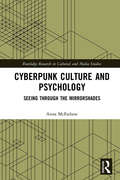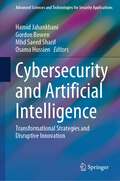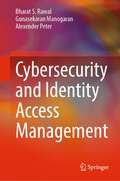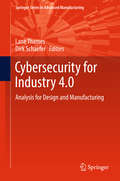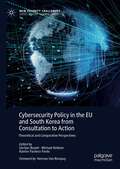- Table View
- List View
Cyberpunk and Visual Culture
by Graham Murphy Lars SchmeinkWithin the expansive mediascape of the 1980s and 1990s, cyberpunk’s aesthetics took firm root, relying heavily on visual motifs for its near-future splendor saturated in media technologies, both real and fictitious. As today’s realities look increasingly like the futures forecast in science fiction, cyberpunk speaks to our contemporary moment and as a cultural formation dominates our 21st century techno-digital landscapes. The 15 essays gathered in this volume engage the social and cultural changes that define and address the visual language and aesthetic repertoire of cyberpunk – from cybernetic organisms to light, energy, and data flows, from video screens to cityscapes, from the vibrant energy of today’s video games to the visual hues of comic book panels, and more. Cyberpunk and Visual Culture provides critical analysis, close readings, and aesthetic interpretations of exactly those visual elements that define cyberpunk today, moving beyond the limitations of merely printed text to also focus on the meaningfulness of images, forms, and compositions that are the heart and lifeblood of cyberpunk graphic novels, films, television shows, and video games.
Cyberpunk Culture and Psychology: Seeing through the Mirrorshades (Routledge Research in Cultural and Media Studies)
by Anna McFarlaneThis book traces developments in cyberpunk culture through a close engagement with the novels of the ‘godfather of cyberpunk’, William Gibson. Connecting his relational model of ‘gestalt’ psychology and imagery with that of the posthuman networked identities found in cyberpunk, the author draws out relations with key cultural moments of the last 40 years: postmodernism, posthumanism, 9/11, and the Anthropocene. By identifying cyberpunk ways of seeing with cyberpunk ways of being, the author shows how a visual style is crucial to cyberpunk on a philosophical level, as well as on an aesthetic level. Tracing a trajectory over Gibson’s work that brings him from an emphasis on the visual that elevates the human over posthuman entities to a perspective based on touch, a truly posthuman understanding of humans as networked with their environments, she argues for connections between the visual and the posthuman that have not been explored elsewhere, and that have implications for future work in posthumanism and the arts. Proposing an innovative model of reading through gestalt psychology, this book will be of key importance to scholars and students in the medical humanities, posthumanism, literary and cultural studies, dystopian and utopian studies, and psychology.
Cyberpunk Culture and Psychology: Seeing through the Mirrorshades (Routledge Research in Cultural and Media Studies)
by Anna McFarlaneThis book traces developments in cyberpunk culture through a close engagement with the novels of the ‘godfather of cyberpunk’, William Gibson. Connecting his relational model of ‘gestalt’ psychology and imagery with that of the posthuman networked identities found in cyberpunk, the author draws out relations with key cultural moments of the last 40 years: postmodernism, posthumanism, 9/11, and the Anthropocene. By identifying cyberpunk ways of seeing with cyberpunk ways of being, the author shows how a visual style is crucial to cyberpunk on a philosophical level, as well as on an aesthetic level. Tracing a trajectory over Gibson’s work that brings him from an emphasis on the visual that elevates the human over posthuman entities to a perspective based on touch, a truly posthuman understanding of humans as networked with their environments, she argues for connections between the visual and the posthuman that have not been explored elsewhere, and that have implications for future work in posthumanism and the arts. Proposing an innovative model of reading through gestalt psychology, this book will be of key importance to scholars and students in the medical humanities, posthumanism, literary and cultural studies, dystopian and utopian studies, and psychology.
Cybersecurity: Protecting Critical Infrastructures from Cyber Attack and Cyber Warfare
by Thomas A. JohnsonThe World Economic Forum regards the threat of cyber attack as one of the top five global risks confronting nations of the world today. Cyber attacks are increasingly targeting the core functions of the economies in nations throughout the world. The threat to attack critical infrastructures, disrupt critical services, and induce a wide range of dam
Cybersecurity: Protecting Critical Infrastructures from Cyber Attack and Cyber Warfare
by Thomas A. JohnsonThe World Economic Forum regards the threat of cyber attack as one of the top five global risks confronting nations of the world today. Cyber attacks are increasingly targeting the core functions of the economies in nations throughout the world. The threat to attack critical infrastructures, disrupt critical services, and induce a wide range of dam
Cybersecurity and Artificial Intelligence: Transformational Strategies and Disruptive Innovation (Advanced Sciences and Technologies for Security Applications)
by Hamid Jahankhani Gordon Bowen Mhd Saeed Sharif Osama HussienThis book discusses a range of topics that are essential to understanding cyber security, including legal implications and technical aspects, cyber detection, and minimising the threats so that governments and organisations can function without noticeable degradation of service. Unlike other technological threats, cyber security threats have the potential to destroy governments and undermine democratic processes – which makes an overarching cyber security strategy essential for all functioning governments. Thus, the book serves as a guide for developing strategies and ideas in the field and as a motivator for other governments and interested parties to develop and implement effective strategies. Arguably the most difficult aspect of these strategies is their implementation, which will require a cultural sea change in governments’ approaches to handling cyber security and developing a regulatory framework that links organisations and governments in a secure working environment. The development of cyber security strategies calls for new skills at the technical and user levels alike. However, IT skills are sometimes in short supply, and without a government policy on cyber security training, the lack of these skills could hamper the full potential of cyber security. The book explores various aspects and challenges of cyber security strategy and highlights the benefits and drawbacks, offering in-depth insights into the field.
Cybersecurity and Identity Access Management
by Bharat S. Rawal Gunasekaran Manogaran Alexender PeterThis textbook provides a comprehensive, thorough and up-to-date treatment of topics in cyber security, cyber-attacks, ethical hacking, and cyber crimes prevention. It discusses the different third-party attacks and hacking processes which a poses a big issue in terms of data damage or theft. The book then highlights the cyber security protection techniques and overall risk assessments to detect and resolve these issues at the beginning stage to minimize data loss or damage. This book is written in a way that it presents the topics in a simplified holistic and pedagogical manner with end-of chapter exercises and examples to cater to undergraduate students, engineers and scientists who will benefit from this approach.
Cybersecurity Awareness (Advances in Information Security #88)
by Jerry Andriessen Thomas Schaberreiter Alexandros Papanikolaou Juha RöningThis contributed volume tells the story of the establishment of a cybersecurity awareness framework for organizations, and how it was piloted in two public sector municipal contexts. It presents a clear picture of cybersecurity issues in municipalities and proposes a socio-technical solution for creating cybersecurity awareness, how to build the solution and what the impact is on the municipal contexts. The 9 chapters for this book also provide information regarding the design, the deployment and the evaluation of the technology.This book builds on the success of the European Horizon 2020 research and innovation project CS-AWARE. The research proposes the first cybersecurity situational awareness solution for local public administrations based on an analysis of the context, provides automatic incident detection and visualization, and enables information exchange with relevant national and EU level authorities involved in legislation and network security.Cybersecurity is one of the most challenging security problems for commercial companies, NGOs, governmental institutions as well as individuals. Reaching beyond the technology focused boundaries of classical information technology (IT) security, cybersecurity includes organizational and behavioral aspects of IT systems and that needs to comply to legal and regulatory framework for cybersecurity. While large corporations might have the resources to follow those developments and bring their IT infrastructure and services in line with the requirements, the burden for smaller organizations like local public administrations will be substantial and the required resources might not be available. New and innovative solutions that would help local public administration to ease the burden of being in line with cybersecurity requirements are needed.This book targets researchers working in cybersecurity, computer scientists, social scientists and advanced level students studying computer science and other related disciplines. Cybersecurity professionals as well as professionals working in local government contexts, including policy makers, communication experts and system administrators will also benefit from this book.
Cybersecurity Challenges in the Age of AI, Space Communications and Cyborgs: Proceedings of the 15th International Conference on Global Security, Safety and Sustainability, London, October 2023 (Advanced Sciences and Technologies for Security Applications)
by Hamid JahankhaniThis book provides an opportunity for researchers, scientists, government officials, strategist and operators and maintainers of large, complex and advanced systems and infrastructure to update their knowledge with the state of best practice in the challenging domains while networking with the leading representatives, researchers and solution providers. The advancement of Artificial Intelligence (AI), coupled with the prolificacy of the Internet of Things (IoT) devices are creating smart societies that are interconnected. Space exploration and satellite, drone and UAV technology have travelled a long way in recent years and some may debate that we are in the midst of a revolution; in terms of development and the increasing number of these devices being launched. But with this revolutionary progress, it presents itself with new challenges in terms of governance. The ethical implications of connecting the physical and digital worlds, and presenting the reality of a truly interconnected society, presents the realization of the concept of smart societies in reality.Drawing on 14 years of successful events on Information security, digital forensics and cybercrime, the 15th ICGS3-23 conference aims to provide attendees with an information-packed agenda with representatives from across the industry and the globe. The challenges of complexity, rapid pace of change and risk/opportunity issues associated with modern products, systems, special events and infrastructures. In an era of unprecedented volatile, political and economic environment across the world, computer based systems face ever more increasing challenges, disputes and responsibilities and while the Internet has created a global platform for the exchange of ideas, goods and services, however, it has also created boundless opportunities for cyber-crime.This book presents new materials and contributes to knowledge through the technological advances that are being made across artificial intelligence (AI), machine learning, blockchain and quantum computing. These technologies driven by a digital revolution are expected to be disruptive and provide major digital transformation in the way societies operate today. As a result, these advances provide social and economic benefits, but, also, provide new challenges that security industry need to raise their game to combat them.
Cybersecurity Ethics: An Introduction
by Mary ManjikianThis textbook offers an accessible introduction to the topic of cybersecurity ethics. The second edition has been revised and updated, and contains new chapters on social justice, AI, and Big Data. The book is split into three parts. Part I provides an introduction to the field of ethics, philosophy, and philosophy of science, three ethical frameworks – virtue ethics, utilitarian ethics, and communitarian ethics – and the notion of ethical hacking. Part II applies these frameworks to particular issues within the field of cybersecurity, including privacy rights, surveillance, and intellectual property. The third part concludes by exploring current codes of ethics used in cybersecurity, with chapters on artificial intelligence, social diversity, Big Data, and cyberwarfare. The overall aims of the book are to: Provide ethical frameworks to aid decision-making Present the key ethical issues in relation to computer security Highlight the connection between values and beliefs and the professional code of ethics The textbook also includes three different features to aid students: "Going Deeper" features provide background on individuals, events, and institutions in cybersecurity; "Critical Issues" features contemporary case studies; and "Tech Talks" contain features that assume some familiarity with technological developments. The book will be of much interest to students of cybersecurity, cyberethics, hacking, surveillance studies, ethics, and information science.
Cybersecurity Ethics: An Introduction
by Mary ManjikianThis textbook offers an accessible introduction to the topic of cybersecurity ethics. The second edition has been revised and updated, and contains new chapters on social justice, AI, and Big Data. The book is split into three parts. Part I provides an introduction to the field of ethics, philosophy, and philosophy of science, three ethical frameworks – virtue ethics, utilitarian ethics, and communitarian ethics – and the notion of ethical hacking. Part II applies these frameworks to particular issues within the field of cybersecurity, including privacy rights, surveillance, and intellectual property. The third part concludes by exploring current codes of ethics used in cybersecurity, with chapters on artificial intelligence, social diversity, Big Data, and cyberwarfare. The overall aims of the book are to: Provide ethical frameworks to aid decision-making Present the key ethical issues in relation to computer security Highlight the connection between values and beliefs and the professional code of ethics The textbook also includes three different features to aid students: "Going Deeper" features provide background on individuals, events, and institutions in cybersecurity; "Critical Issues" features contemporary case studies; and "Tech Talks" contain features that assume some familiarity with technological developments. The book will be of much interest to students of cybersecurity, cyberethics, hacking, surveillance studies, ethics, and information science.
Cybersecurity for Industrial Control Systems: SCADA, DCS, PLC, HMI, and SIS
by Tyson Macaulay Bryan L. SingerAs industrial control systems (ICS), including SCADA, DCS, and other process control networks, become Internet-facing, they expose crucial services to attack. Threats like Duqu, a sophisticated worm found in the wild that appeared to share portions of its code with the Stuxnet worm, emerge with increasing frequency. Explaining how to develop and im
Cybersecurity for Industrial Control Systems: SCADA, DCS, PLC, HMI, and SIS
by Tyson Macaulay Bryan L. SingerAs industrial control systems (ICS), including SCADA, DCS, and other process control networks, become Internet-facing, they expose crucial services to attack. Threats like Duqu, a sophisticated worm found in the wild that appeared to share portions of its code with the Stuxnet worm, emerge with increasing frequency. Explaining how to develop and im
Cybersecurity for Industry 4.0: Analysis for Design and Manufacturing (Springer Series in Advanced Manufacturing)
by Lane Thames Dirk SchaeferThis book introduces readers to cybersecurity and its impact on the realization of the Industry 4.0 vision. It covers the technological foundations of cybersecurity within the scope of the Industry 4.0 landscape and details the existing cybersecurity threats faced by Industry 4.0, as well as state-of-the-art solutions with regard to both academic research and practical implementations. Industry 4.0 and its associated technologies, such as the Industrial Internet of Things and cloud-based design and manufacturing systems are examined, along with their disruptive innovations. Further, the book analyzes how these phenomena capitalize on the economies of scale provided by the Internet.The book offers a valuable resource for practicing engineers and decision makers in industry, as well as researchers in the design and manufacturing communities and all those interested in Industry 4.0 and cybersecurity.
Cybersecurity for Reconfigurable Hardware Based Critical Infrastructures
by Krishnendu Guha Jyoti Prakash Singh Amlan ChakrabartiThe book commences with an introductory section on reconfigurable computing and thereafter delves into its applications in critical infrastructures. This book analyzes how such systems may be affected due to vulnerabilities and also discusses how these can be attacked by adversaries or cybercriminals. This book also discusses protection mechanisms related to such threats. It initially starts with an introduction to the various industrial revolutions and the changes in security needs, followed by a basic description of reconfigurable hardware based critical infrastructures. Further, the book contains discussion on security administration and planning, auditing, monitoring and analysis, risk-response and recovery, control and countermeasures highlighting their need in reconfigurable hardware-based platforms. In addition to these, new concepts are introduced such as AI/ML for cybersecurity, digital forensics related to reconfigurable hardware based critical infrastructures. Finally, a hands on learning experience is presented to provide the readers with a practical flavour. The book will be useful to students (graduate and undergraduate), researchers, academicians and industry professionals.
Cybersecurity in Morocco (SpringerBriefs in Cybersecurity)
by Yassine Maleh Youness MalehThis SpringerBrief contains eight chapters and presents an overview of the evolution of the Moroccan Cybersecurity Strategy. It also draws attention to the development of cybersecurity in Morocco and to ensure national security in the context of the current and developing information confrontation in the international community. However, it cannot promise to provide an in-depth examination. The issue of cybersecurity is simply too wide-ranging for our purposes. This acknowledgment is meant to encourage more detailed research into the broader topics covered in this brief to better inform current approaches to national cybersecurity performance evaluation.This SpringerBrief targets researchers interested in exploring and understanding Morocco and its efforts in implementing its national cybersecurity strategy. This brief is also a relevant reference for diplomats, executives, CISOs, cybersecurity professionals and engineers working in this related field.
Cybersecurity in Nigeria: A Case Study of Surveillance and Prevention of Digital Crime (SpringerBriefs in Cybersecurity)
by Aamo IorliamThis book reviews the use of digital surveillance for detecting, investigating and interpreting fraud associated with critical cyberinfrastructures in Nigeria, as it is well known that the country’s cyberspace and cyberinfrastructures are very porous, leaving too much room for cyber-attackers to freely operate. In 2017, there were 3,500 successful cyber-attacks on Nigerian cyberspace, which led to the country losing an estimated 450 million dollars. These cybercrimes are hampering Nigeria’s digital economy, and also help to explain why many Nigerians remain skeptical about Internet marketing and online transactions. If sensitive conversations using digital devices are not well monitored, Nigeria will be vulnerable to cyber-warfare, and its digital economy, military intelligence, and related sensitive industries will also suffer. The Nigerian Army Cyber Warfare Command was established in 2018 in order to combat terrorism, banditry, and other attacks by criminal groups in Nigeria. However, there remains an urgent need to produce digital surveillance software to help law enforcement agencies in Nigeria to detect and prevent these digitally facilitated crimes. The monitoring of Nigeria’s cyberspace and cyberinfrastructure has become imperative, given that the rate of criminal activities using technology has increased tremendously. In this regard, digital surveillance includes both passive forensic investigations (where an attack has already occurred) and active forensic investigations (real-time investigations that track attackers). In addition to reviewing the latest mobile device forensics, this book covers natural laws (Benford’s Law and Zipf’s Law) for network traffic analysis, mobile forensic tools, and digital surveillance software (e.g., A-BOT). It offers valuable insights into how digital surveillance software can be used to detect and prevent digitally facilitated crimes in Nigeria, and highlights the benefits of adopting digital surveillance software in Nigeria and other countries facing the same issues.
Cybersecurity in Poland: Legal Aspects
by Katarzyna Chałubińska-Jentkiewicz Filip Radoniewicz Tadeusz ZielińskiThis open access book explores the legal aspects of cybersecurity in Poland. The authors are not limited to the framework created by the NCSA (National Cybersecurity System Act – this act was the first attempt to create a legal regulation of cybersecurity and, in addition, has implemented the provisions of the NIS Directive) but may discuss a number of other issues. The book presents international and EU regulations in the field of cybersecurity and issues pertinent to combating cybercrime and cyberterrorism. Moreover, regulations concerning cybercrime in a few select European countries are presented in addition to the problem of collision of state actions in ensuring cybersecurity and human rights. The advantages of the book include a comprehensive and synthetic approach to the issues related to the cybersecurity system of the Republic of Poland, a research perspective that takes as the basic level of analysis issues related to the security of the state and citizens, and the analysis of additional issues related to cybersecurity, such as cybercrime, cyberterrorism, and the problem of collision between states ensuring security cybernetics and human rights. The book targets a wide range of readers, especially scientists and researchers, members of legislative bodies, practitioners (especially judges, prosecutors, lawyers, law enforcement officials), experts in the field of IT security, and officials of public authorities. Most authors are scholars and researchers at the War Studies University in Warsaw. Some of them work at the Academic Centre for Cybersecurity Policy – a thinktank created by the Ministry of National Defence of the Republic of Poland.
Cybersecurity in Switzerland (SpringerBriefs in Cybersecurity)
by Myriam Dunn CaveltyGives the reader a detailed account of how cyber-security in Switzerland has evolved over the years, using official documents and a considerable amount of inside knowledge. It focuses on key ideas, institutional arrangements, on the publication of strategy papers, and importantly, on processes leading up to these strategy documents.The peculiarities of the Swiss political system, which influence the way cyber-security can be designed and practiced in Switzerland are considered, as well as the bigger, global influences and driving factors that shaped the Swiss approach to cyber-security. It shows that throughout the years, the most important influence on the Swiss policy-approach was the international level, or rather the developments of a cyber-security policy in other states. Even though many of the basic ideas about information-sharing and public-private partnerships were influenced by (amongst others) the US approach to critical infrastructure protection, the peculiarities of the Swiss political system has led to a particular “Swiss solution”, which is based on the federalist structures and subsidiary principles, characterized by stability and resilience to external shocks in the form of cyber-incidents.Cybersecurity in Switzerland will be a stimulating read for anybody interested in cyber-security policy, including students, researchers, analysts and policy makers. It contains not only specific material on an interesting case, but also a wealth of background information on different variations of cyber-security, as well as on information-sharing and public-private partnerships.
Cybersecurity in the Age of Smart Societies: Proceedings of the 14th International Conference on Global Security, Safety and Sustainability, London, September 2022 (Advanced Sciences and Technologies for Security Applications)
by Hamid JahankhaniThis book provides an opportunity for researchers, scientists, government officials, strategist and operators and maintainers of large, complex and advanced systems and infrastructure to update their knowledge with the state of best practice in the challenging domains whilst networking with the leading representatives, researchers and solution providers. The ongoing pandemic has created a new level of threats which presents new challenges around privacy, data protection, malicious application, unprotected networks or networks with basic protection that are being used as a gateway to larger infrastructure with complicated architecture, and unintentional misuse such as those associated with algorithmic bias. All these have increased the number of attack vectors that can be used to attack such networks. Drawing on 13 years of successful events on information security, digital forensics and cyber-crime, the 14th ICGS3-22 conference aims to provide attendees with an information-packed agenda with representatives from across the industry and the globe. The challenges of complexity, rapid pace of change and risk/opportunity issues associated with modern products, systems, special events and infrastructures. In an era of unprecedented volatile, political and economic environment across the world, computer-based systems face ever more increasing challenges, disputes and responsibilities, and whilst the Internet has created a global platform for the exchange of ideas, goods and services, it has also created boundless opportunities for cyber-crime. This volume presents new materials and contribute to knowledge through the technological advances that are being made across artificial intelligence (AI), machine learning, blockchain and quantum computing. These technologies driven by a digital revolution are expected to be disruptive and provide major digital transformation in the way societies operate today. As result, although these advances provide social and economic benefits, but, also, provide new challenges that security industry need to raise their game to combat them.
Cybersecurity Policy in the EU and South Korea from Consultation to Action: Theoretical and Comparative Perspectives (New Security Challenges)
by Gertjan Boulet Michael Reiterer Ramon Pacheco PardoThis book offers a very interesting deep-dive into EU and South Korean approaches to cybersecurity issues. In a unique approach, the editors and authors focus on the potential for strategic partnership and shared lessons learned given common commitments to democracy, human rights, the free market, and a rules-based international order of the two regions. Essential reading for students and researchers in political science, international relations, international law, strategic and defence studies, computer science, and cognitive science.
Cybersecurity, Privacy and Freedom Protection in the Connected World: Proceedings of the 13th International Conference on Global Security, Safety and Sustainability, London, January 2021 (Advanced Sciences and Technologies for Security Applications)
by Hamid Jahankhani Arshad Jamal Shaun LawsonThis book provides an opportunity for investigators, government officials, systems scientists, strategists, assurance researchers, owners, operators and maintainers of large, complex and advanced systems and infrastructures to update their knowledge with the state of best practice in the challenging domains whilst networking with the leading representatives, researchers and solution providers. Drawing on 12 years of successful events on information security, digital forensics and cyber-crime, the 13th ICGS3-20 conference aims to provide attendees with an information-packed agenda with representatives from across the industry and the globe. The challenges of complexity, rapid pace of change and risk/opportunity issues associated with modern products, systems, special events and infrastructures. In an era of unprecedented volatile, political and economic environment across the world, computer-based systems face ever more increasing challenges, disputes and responsibilities, and whilst the Internet has created a global platform for the exchange of ideas, goods and services, it has also created boundless opportunities for cyber-crime. As an increasing number of large organizations and individuals use the Internet and its satellite mobile technologies, they are increasingly vulnerable to cyber-crime threats. It is therefore paramount that the security industry raises its game to combat these threats. Whilst there is a huge adoption of technology and smart home devices, comparably, there is a rise of threat vector in the abuse of the technology in domestic violence inflicted through IoT too. All these are an issue of global importance as law enforcement agencies all over the world are struggling to cope.
Cybersexism: Sex, Gender and Power on the Internet
by Laurie Penny'The Internet was supposed to be for everyone... Millions found their voices in this brave new online world; it gave unheard masses the space to speak to each other without limits, across borders, both physical and social. It was supposed to liberate us from gender. But as more and more of our daily lives migrated on line, it seemed it did matter if you were a boy or a girl.' It's a tough time to be a woman on the internet. Over the past two generations, the political map of human relations has been redrawn by feminism and by changes in technology. Together they pose questions about the nature and organisation of society that are deeply challenging to those in power, and in both cases, the backlash is on. In this brave new world, old-style sexism is making itself felt in new and frightening ways. In Cybersexism, Laurie Penny goes to the dark heart of the matter and asks why threats of rape and violence are being used to try to silence female voices, analyses the structure of online misogyny, and makes a case for real freedom of speech – for everyone. Laurie Penny's forthcoming book, Unspeakable Things: Sex, Lies and Revolution, will be published in 2014.
Cyberspace: Risks and Benefits for Society, Security and Development (Advanced Sciences and Technologies for Security Applications)
by J. Martín Ramírez Luis A. García-SeguraThis book covers many aspects of cyberspace, emphasizing not only its possible ‘negative’ challenge as a threat to security, but also its positive influence as an efficient tool for defense as well as a welcome new factor for economic and industrial production. Cyberspace is analyzed from quite different and interdisciplinary perspectives, such as: conceptual and legal, military and socio-civil, psychological, commercial, cyber delinquency, cyber intelligence applied to public and private institutions, as well as the nuclear governance.
Cyberspace Crime
by D. S. WallThis book was published in 2003.This book is a collection of key texts that have contributed towards, or have reflected, the various debates that have taken place over crime and the internet during that past decade. The texts are organised into three parts. The first contains a number of viewpoints and perspectives that facilitate our broader understanding of cyberspace crime/ cybercrimes. The second part addresses each of the major types of cybercrime - trespass/ hacking/cracking, thefts/ deceptions, obscenities/ pornography, violence - and illustrate their associated problems of definition and resolution. The third and final part contains a selection of texts that each deal with the impact of cyberspace crime upon specific criminal justice processes: the police and the trial process.

